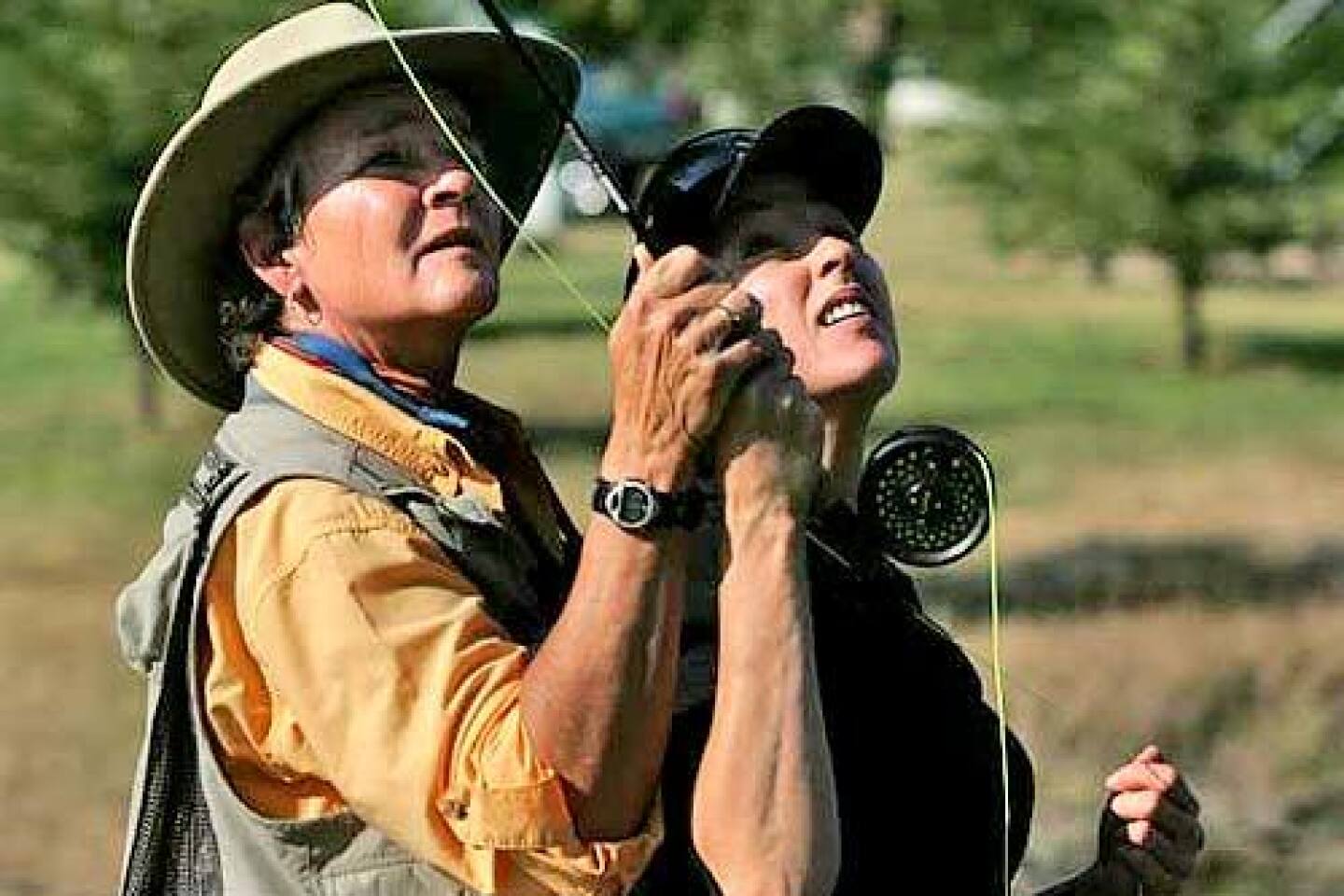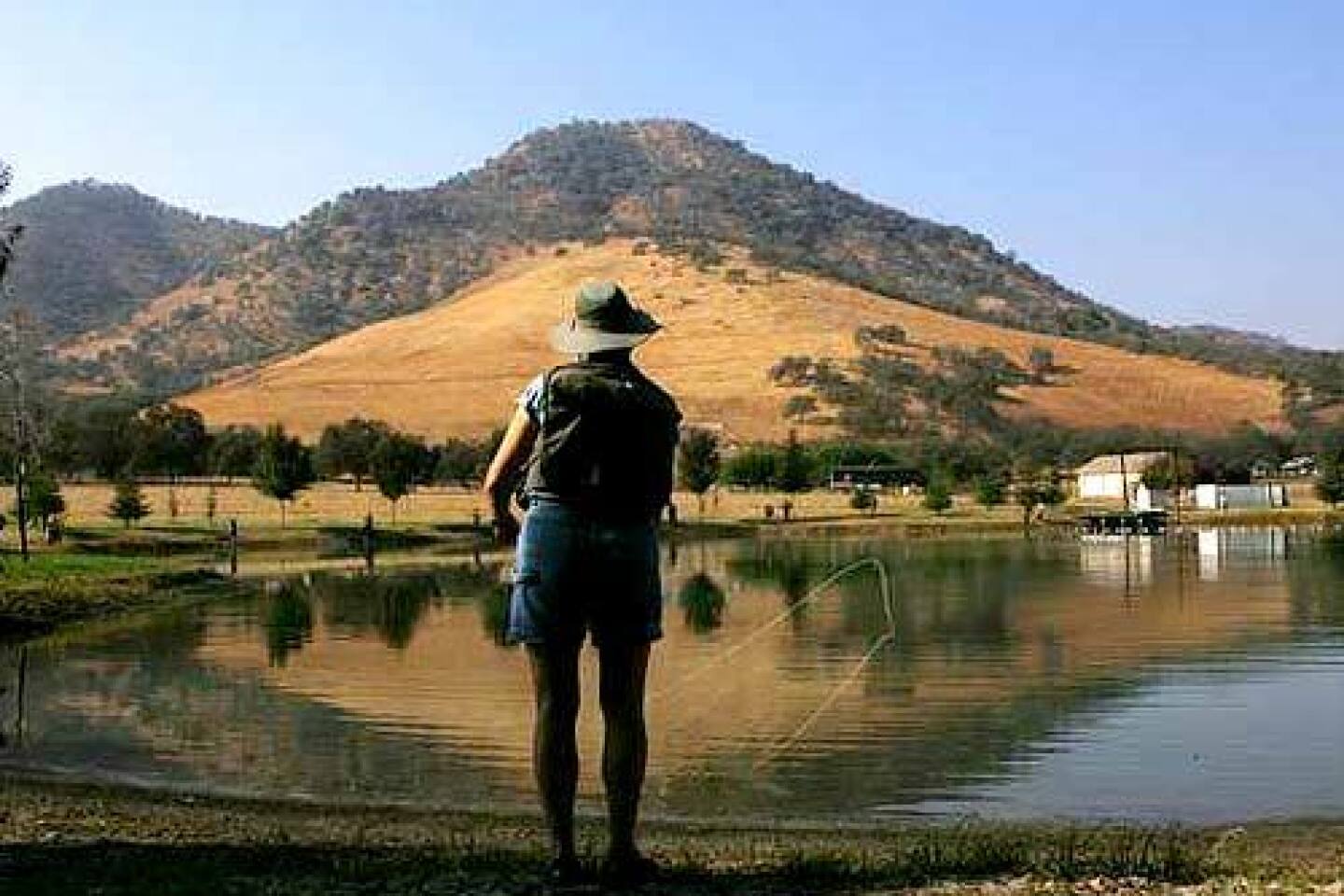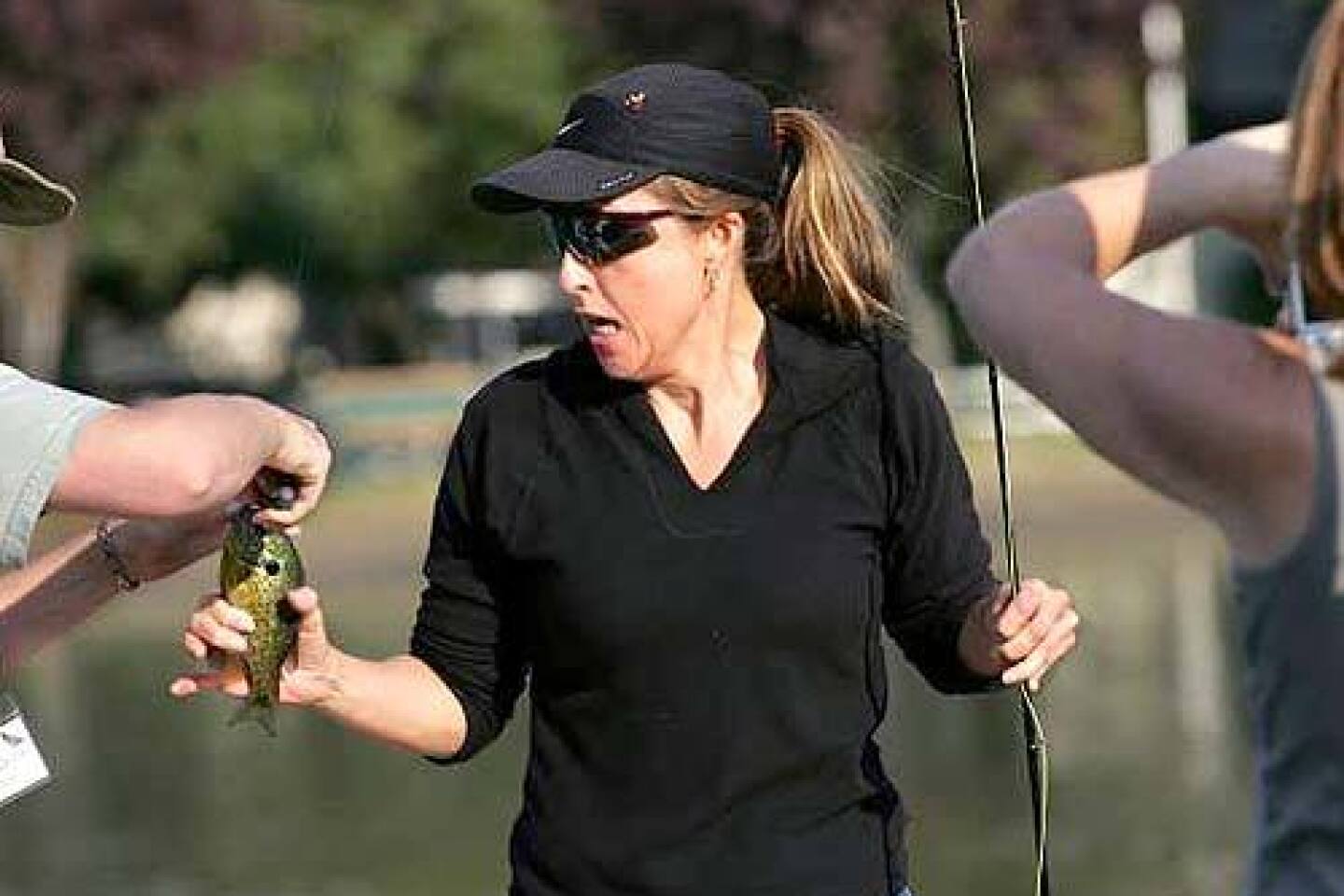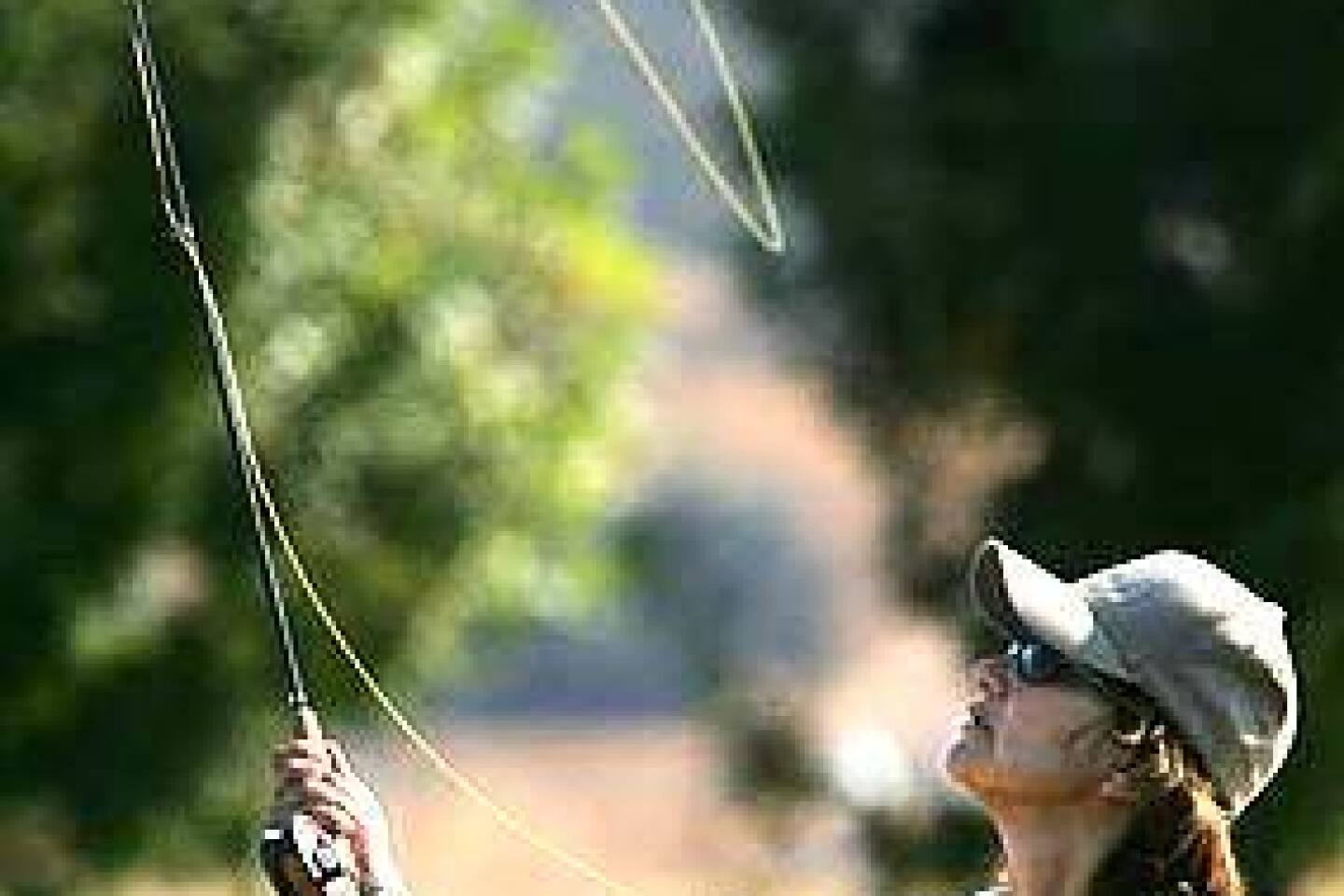Wilderness of their own
- Share via
At a small pond in the Sierra Nevada foothills, a woman casts her fly with a gentle flick. The line sails delicately over the water and settles on the surface. On the opposite bank, other women cook over a campfire. Rainbow-colored kayaks cut across the water, and nearby horses neigh at nothing in particular.
Suddenly, a cheerful expletive explodes across the water, followed by: “I got a fish!”
Janice Mahaffey hops around as if at a snake dance and pulls a 4-inch blue gill out of the water. Her instructor, Sally Stoner, hurries over.
“How do you hold it?” Mahaffey asks, fish wiggling on the line.
Stoner shows her, then unhooks and releases the fish back into the pond. Mahaffey’s fishing pal rushes over and the two high-five each other, then slap each other’s fishing vests Three Stooges-like.
From the opposite bank, half a dozen women let out a mighty wolf howl in an assortment of pitches. The howl barrels up the nearby hills and into the canyons beyond.
Ow, Ow, Ow, Owwww, OOOOooooo.
*
Strength in numbers
MEN are welcome, but only a few intrepid male instructors have ventured into this howling den of womanpower — aka the Becoming an Outdoors Woman multicourse workshop. Held in late October at Wonder Valley Ranch Resort, east of Fresno, BOW — as it is known — teaches outdoors skills for women only.The notion that women would rather learn outdoors skills in the company of other women might seem archaic, even patronizing. But 60 women — twentysomethings to septuagenarians, engineers, doctors, college professors, bookkeepers, lawyers and administrators — have signed on, and none of them seem like the snuffling, hand-wringing type.
For $350, they spend two nights sharing a dormitory-like room and choosing among shooting, fishing, kayaking, archery and orienteering classes.
At a buffet lunch in a packed banquet room on opening day, BOW California president Susan Herrgesell, a diminutive duck-hunting dynamo, kicks off the event. Utensils clatter, then the room grows quiet as Herrgesell riffs on BOW’s 15-year history (begun in Wisconsin; administrated for a time through the California Department of Fish and Game; now a nonprofit on its own), the membership roster (up to 5,000 women have taken its classes) and the growing participation of women in outdoor sports.
“Ten years ago I went to Cabela’s to buy waders,” she says, “and the only thing they offered for women were little sweaters with bunnies or kittens on them.”
The audience howls in appreciation.
“Now they have an entire catalog for women and sponsor women’s sporting events.”
The howling, participants soon learn, evolved from a popular contemporary book that suggests women and wolves have a lot in common. “Women Who Run With the Wolves” is a mix of anthropology, new-age spirituality and self-help, but this crowd isn’t interested in big books. It just likes to howl.
As participants rush out to the first of their classes, they get a final word of advice from one of the instructors: “Remember — what happens in Wonder Valley, stays in Wonder Valley.”
Ow, Ow, Ow, Owwww, OOOOooooo.
*
Guns and philosophy
INTRODUCTION to Firearms & Safety is held in a cabin-like room with a stone fireplace, big wooden beams and stained glass windows. It could feel warm and fuzzy here except for the assortment of shotguns and rifles laid out on a long table at the front of the room. Introductions are brief.“I’m married to a hunter, and I sure don’t want to be taught by him,” says one student.
“My dad was a hunter — a really bad hunter. He’d pick up his shotgun and it would go off. We had holes in the roof,” says another.
“I want to kill a bear that’s harassing my pets,” announces one grandmotherly attorney wrapped in a parka with fur-trimmed hood.
Using an overhead projector, three instructors demonstrate how to lock and load, and pass around various types of ammo. They open the class to questions, which come slowly at first, then:
“What’s the best gun to scare away an intruder?”
A pump-action shotgun, the instructor recommends, picking up one and demonstrating a sound familiar to action-movie fans everywhere.
“What about night scopes?”
Illegal.
“Even for bears?”
If there’s an armchair philosopher for women in the outdoors, it’s Sally Stoner. For three decades, Stoner has taken scores of men and women deep into the wilds of California and Montana and taught them to fish. She believes that women and men approach the outdoors differently and prefers not to teach mixed groups. She believes that women have experienced a culturally driven disconnect from the outdoors.
“Centuries ago,” she says, “we lived outdoors and being in nature was an important part of the rhythm of our existence. In the last 50 years we have gone to live in the concrete jungle and drive the freeways. We have garage door openers, and we don’t even have to interact with our yard.”
In Stoner’s experience, women lead big, busy lives, and when a woman goes outdoors, she attends to the kids first and then to everyone else. “For many women, something is deeply missing,” says Stoner, “and they don’t always know what it is — until they are outdoors with no responsibilities. Then they experience a renewal of something so primal that it speaks to them.”
*
Lessons in the wild
WONDER VALLEY isn’t Walden Pond. The next morning many of the women, even as they scatter around the grounds scouting for classes, are on their cellphones, negotiating delicate family matters back home. There are prom dress issues to resolve, a broken toe, a friend’s new baby. The problems are parsed, resolved, then it’s back to the outdoors.At the map and compass class, students put away cellphones and walk side by side across a freshly cut field in the middle of the resort, as if combing a crime scene.
Nearby, the fly-fishing class practices casting at a volleyball net. Yards and yards of line sail through the air and catch the light as the instructor exhorts: “No wrist, no snapping don’t make us tie the rod to your arm feel the punch, slower the pole’s doing all the work. Oops! Did I say pole?”
Smoke wafts by from the nearby cooking class. On the banks of the pond, beneath swaying sycamores and cotton woods, Augie and Joyce Pando are teaching Dutch oven cooking over a log and charcoal fire. One student realizes her pot is hissing and rattling dangerously.
“Potatoes, stat!” she yells to her cooking partner.
Connie Meyer of St. Helena, a mother of two, takes a break and sits on a bench, her face catching the sun, her curly hair tucked into a cap. She’s primarily there for the shooting classes; her father and brother were both hunters.
“I grew up in a house full of guns and hunting, but it was never passed on to me,” she says, with a slight edge in her voice. “It was taught to the boys.”
One might think that Meyer, who has an easy athleticism and an air of quiet self-confidence, would be at ease in any type of class. She speaks slowly, choosing her words carefully.
“There are things you don’t have to worry about here,” she says squinting up at the sun. “You look around and it’s more relaxed. Men feel there always has to be one alpha, and you can see it developing in a group.”
*
On the hunt
IN a large, scrubby field several miles from the resort, eight women sit on a long bench, with the easy camaraderie of baseball players in a dugout. Under the shade of cottonwoods, they peer nervously at a skeet-throwing machine and wait their turn to blast a 20-gauge at bright orange clay pigeons.Wearing oversized hunting vests and large blue ear protectors, they look more like the Bad News Bears with earmuffs than future hunters.
They watch as a fellow student positions the pump-action shotgun against her shoulder and peers down the barrel.
“Pull!”
A small, orange disk goes sailing over the field, and she squeezes the trigger. The gun recoils against her shoulder as the disk falls to the ground, intact.
“We definitely need bigger clay pigeons,” says one of the bench warmers.
“Yeah, I think they need to be the size of a dinner plate,” suggests one.
“More like a garbage lid,” offers another.
But by the end of the session, a few turn out to be excellent shots. Cynthia Boriskin hits several in rapid succession. A star is born.
The afternoon fly-fishing session finds a dozen women fanned out around the pond casting lines with increasing confidence. Some of them arrived together the day before waving bottles of wine, beautifully coifed and made up, looking like city slickers who were headed for a Barney’s sale and took a wrong turn. A gambler might lay odds against them staying, but they are tougher than they look. In fact, two of them have trekked up Yosemite’s Half Dome.
Until the workshop, Mahaffey had never caught a fish. But in today’s fly-fishing class, she gets a bite — her second of the day. Her first was the successful catch and release, and this time she pulls the fish in with authority, but there’s a problem. The fish has swallowed the fly. Stoner gets out her pliers and pulls the hook up through the fish’s gullet, ripping cartilage along the way. Blood spills onto the pliers. Mahaffey gulps as she looks at the fish, then up at Stoner.
“Do you think he’s going to make it?”
Stoner isn’t surprised by Mahaffey’s sudden squeamishness.
In fact, one of her students dropped out of her fishing class. “She asked me, ‘Why do you do this? How do you justify it?’ ” Stoner says. “She couldn’t wrap her arms around the fact that she was going to kill an animal. In my experience, women consider the consequences more.”
*
A social group
ON the last day, Exploring Wild California is filled to capacity. The women get a quick primer on binoculars, ticks and poison oak, then head outside and learn how to tell a coyote track from a fox paw print. After two days of paddling, casting, shooting and belly-crawling, the students are happy just talking among themselves and poking around at scat.Stoner believes that women are more inclined than men to experience outdoor sports as social opportunities.
“Women generally like to fish in groups,” she says. “You rarely see a woman jump in a pickup truck and spend a week alone eating out of a sardine can. A lot of women go fishing and don’t remember how many fish they caught. For them, it’s all about the experience.”
For Boriskin, the star marksman, being outdoors is all about family — and bridging an invisible gulf.
“My dad was an avid hunter,” says Boriskin, standing in the shadow of a pomegranate tree, heavy with fruit. “He was born in Red Bluff. He was one of 12 kids and he was the only hunter, but it was in his blood. He loved the outdoors and respected it. He always took my brother hunting, and he brought me along to retrieve the birds.”
Behind her, crows call to each other, hopping among the trees.
“He taught us how to clean our game and that if you kill it, you need to eat it. When he passed away three years ago, no one wanted his guns so I took them. I guess I inherited his genes. I want to keep the legacy,” she says, wiping away a tear. “I really miss him.”
*
Feel like howling? For more information on BOW California classes: (707)448-1230 or https://www.bowcalifornia.org
*
Janet Cromley can be reached at janet.cromley@latimes.com.
More to Read
Sign up for Essential California
The most important California stories and recommendations in your inbox every morning.
You may occasionally receive promotional content from the Los Angeles Times.























